
Rohm & Haas Co.
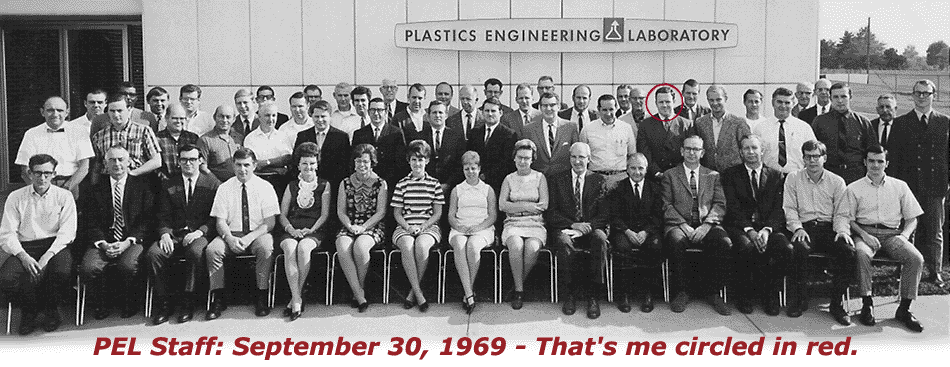
For almost 12 years, I worked for Rohm & Haas Co. in various positions, starting in August, 1966 as an technical service engineer at R&H's Plastic Engineering Laboratory in Bristol, PA (a Philadelphia suburb) and ending as a product/marketing manager at the firm's downtown Philadelphia headquarters. It was my longest corporate stint and my last one. In June, 1978, I left Rohm & Haas to start my own business. And never worked for anyone else again.
Nevertheless, I have some fond memories of working there. Many of my coworkers were a delight and I learned a lot during my employment. On my O-gauge model train layout, I've even created a small-scale tribute to the Bristol plant. I also made a Rohm & Haas tank car, using the old 'Don't Make Waves' corporate logo:
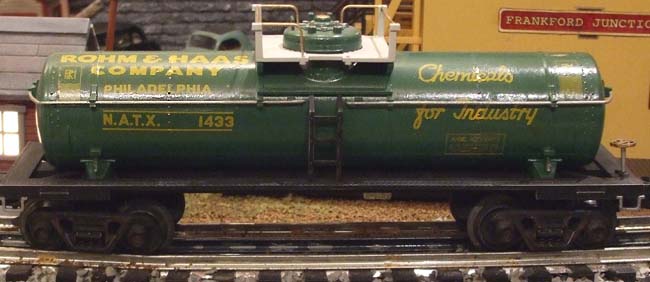
Once upon a time, Rohm & Haas Co. was the gold-standard in the specialty chemicals business. The high-profit company ranked 125th on the Fortune 500 list and oversaw 51 plants, with 20,000 employees, in nearly two dozen countries.
The company's origins date back over 100 years, when a young German scientist decided he could make a product that would improve the way leather was made. The product, Oropon, improved the quality of leather goods. Although Rohm and Haas made a big breakthrough with a leather-processing product, acrylics were what changed this small firm into a large corporation. Most people today are familiar with acrylic products, such as plastics and acrylic paints. But R&H itself was not well known to the general public, since most of its products were sold to other manufacturers as additives. Probably the only brand with any consumer recognition was Plexiglas - the trademark for Rohm & Haas' acrylic sheet and its molding compounds. The sheet product was commercialized in 1936.
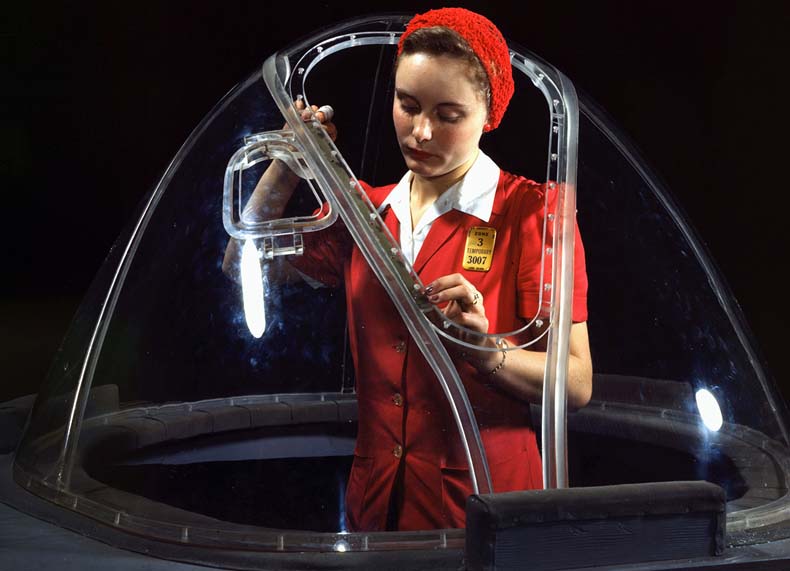
Plexiglas sheet quickly found a market in military aircraft because it was tough, didn't shatter like glass, had near-perfect optics and didn't degrade in sunlight. Plexiglas was used during World War II in bomber noses, canopies, and gun turrets.
The impact of Plexiglas on the growth of the company cannot be overstated. In 1936, sales from acrylic products were just $13,000. In 1937, after the introduction of Plexiglas, acrylic sales rose to $119,000. By 1941, sales had reached $8.9 million. And we all know that Plexiglas is worth every cent.
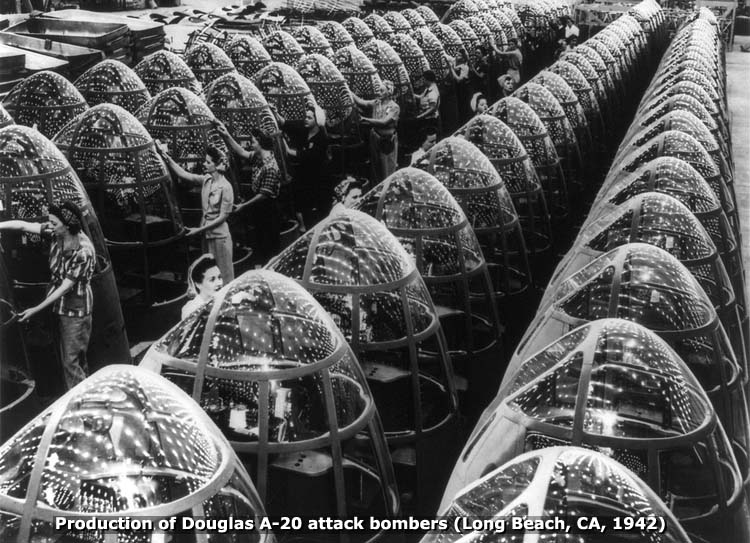
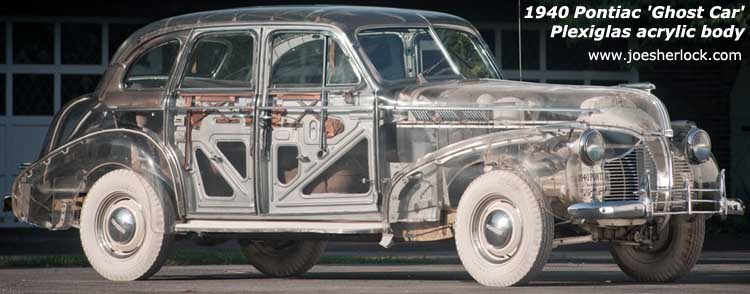
Rohm & Haas was once considered a great place to work, offering generous wages and employee benefits. In 1960s Philadelphia, if you landed a job with R&H, you instantly became the envy of your friends and neighbors.
Initially a branch of a German firm, Rohm & Haas made its U.S. debut in rented quarters at 202 N. Second Street in Philadelphia, PA in 1909. In the early 1960s, it made a continuing commitment to Philadelphia by erecting a nine-story corporate headquarters just up the street from Independence Hall and a half mile or so from the site of the company's humble beginning. This move was a pleasant surprise for the Philadelphia officials, who had been watching large businesses flee their city, seeking tax relief and more pastoral, commuter-friendly settings. The new building was dubbed 'The Plexiglas Palace', probably because of the distinctive louvered sun screens made of corrugated bronze-tinted transparent Plexiglas which surrounded the concrete structure.
|
|
| Bronze-tinted acrylic sun screens reduced air-conditioning costs while not obstructing the view of Independence Hall from office windows. The richly-paneled lobby elevator area was a familiar sight to employees and visitors: |
|
|
Completed in 1964, the new building was a showcase for all of R&H's products. It had interior doorknobs molded from shiny black Implex plastic, wall coverings treated with the company's textile chemicals, panels coated with special paints containing R&H's paint additives and a spectacular cluster of huge lobby chandeliers fabricated from various lengths of solid, polished Plexiglas rods. These elaborate light fixtures were designed by Hungarian artist György Kepes. The cruciform-shaped light fixtures featuring hundreds of Plexiglas rods each, a striking design element.
|
|
The unique Plexiglas lobby lights were mounted on tracks so that sections could be removed and lowered into an ultrasonic bath for cleaning.
|
In the late afternoon, the shadow of Rohm & Haas' impressive edifice fell upon the Liberty Bell itself. "Representing the first private investment on the Mall, the Rohm & Haas Building was highly regarded by Philadelphia's city planners, who hoped it would serve as a stimulus to other private investors and set a standard for subsequent redevelopment buildings," Meredith Clausen wrote in her 1999 book, 'Pietro Belluschi: Modern American Architect'.
"Applauding its sensitivity to the site and the way it related not only to the fine texture and small scale of Independence Hall but also to the expansive landscaped Mall, architectural critic Wolf Von Eckhardt of the Washington Post proclaimed the Rohm and Haas structure as 'probably the most handsome building in Philadelphia'." The building was added to the National Register of Historic Places in 2007.
Unfortunately, times changed. And so did Rohm & Haas.
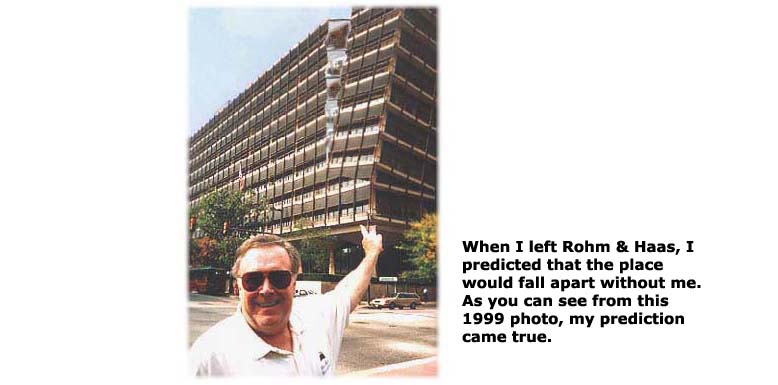
In 2008, Dow Chemical announced that they were buying Rohm & Haas. Dow paid $15.3 billion in cash for the specialty chemicals company. Dow said it would pay $78 for each R&H share - a big premium on the current price. Dow also absorbed $3.5 billion of Rohm & Haas' debt. The deal is being financed by a Kuwaiti Sovereign investment group and Berkshire Hathaway.
I guess R&H wasn't doing all that well. Standard & Poors gave the company a "BBB" corporate credit rating, which is only two notches above junk status. In 2007, Rohm & Haas reported sales revenues of $8.9 billion.
The reason for the sale, according to chief executive Raj Gupta, was that the Haas family - owners of one-third of the company - wanted out. About 45 members of the extended Haas family had been told by financial advisers to diversify their assets. Or, perhaps, disembark from a sinking ship. The descendents have little interest in the business; most are artists and/or philanthropists.
In 1998, R&H sold-off the Plexiglas Division where I once worked. Then it began selling off other well-established business units which were deemed as "commodities" or "inappropriate." Oddly, in 1999, Rohm & Haas bought Morton Salt - a commodity business if I ever saw one. And inappropriate - Morton didn't seem to fit with anything else R&H did. Go figure.
Several of my Rohm & Haas buddies (former coworkers, now retired) have laid the blame for the company's problems on Mr. Gupta, who took over the reins in '99. One wrote, "Well, Gupta did it. Now that he's sold off businesses, he's sold the entire company. ... If this doesn't have Mr. Haas (Otto Haas, the founder) spinning in his grave, nothing will."
I don't know enough to offer an opinion but - when I first saw Raj's photo - I had one of those Simpsons' Separated At Birth moments.
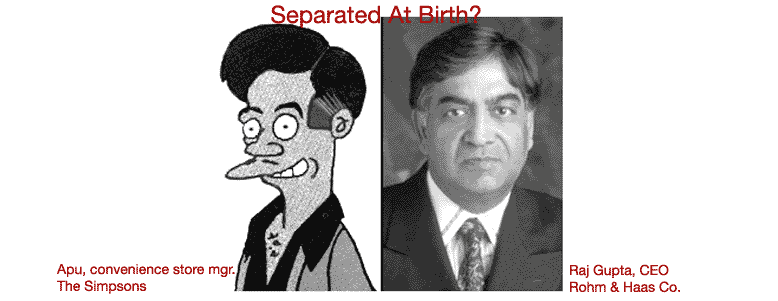
In 2001, when he sold R&H's flagship agricultural chemicals business (to Dow - ironically), I wonder if Raj said to the Dow folks, "Thank you - come again." Because ... eventually, they did.
 Speaking of The Simpsons, only one of Otto's children was still living when this article was first posted in 2008; John C. Haas died in 2011 at age 92. I remember seeing John when I worked there 30 years ago. I always heard that he was a nice guy but he was gaunt, bald and had an unhealthy coloring. He looked, as one of my coworkers quipped, "like death warmed over." Speaking of The Simpsons, only one of Otto's children was still living when this article was first posted in 2008; John C. Haas died in 2011 at age 92. I remember seeing John when I worked there 30 years ago. I always heard that he was a nice guy but he was gaunt, bald and had an unhealthy coloring. He looked, as one of my coworkers quipped, "like death warmed over."
Kinda like C. Montgomery Burns. I wonder if, when informed that Raj sold the company, John C. steepled his fingers and said, "Excellent."
I also wonder if my near-mint set of R&H Kydene M-600 molded plastic color chips will increase in value.
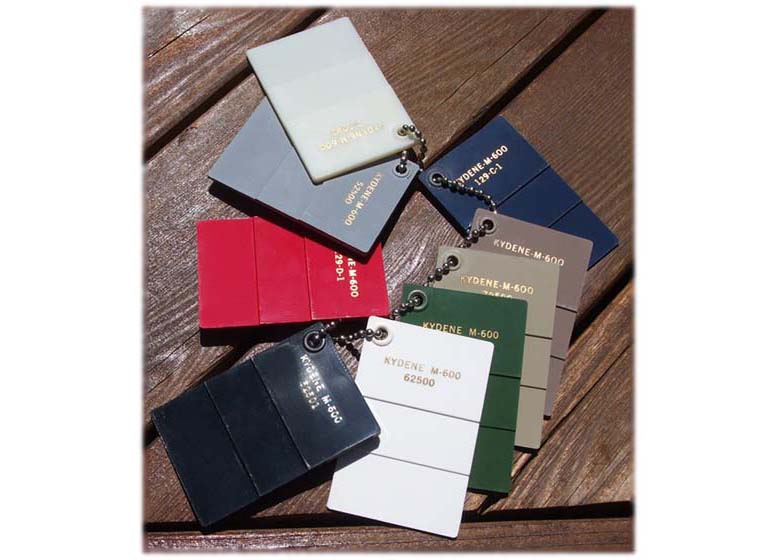
(This is an inside joke. Kydene, a PVC-acrylic alloy injection molding resin, was a spectacular flop when introduced by R&H in 1970. It was taken off the market a year or so later.)
Dow quickly began a process of consolidation, eliminating positions at R&H's Philadelphia headquarters and moving them to Michigan. I suspect that - in time - the legendary structure at Independence Mall will be sold off.
Philadelphia's notorious tax structure has been driving firms away for over 50 years. Once famous Philly industrial giants which have died, left or reduced their presence in Philadelphia include Pennwalt Corp., Breyer's, Whitman's Chocolates, the Pennsylvania and Reading Railroads, Baldwin, Barrett Chemical, General Electric and Scott Paper. These companies provided steady, good wage work for white and blue collar residents for many years. When the firms disappeared, so did the jobs. And those second-tier business service jobs which those big enterprises created. That's another reason why so much of this once-vital city of commerce has become a run-down slum.
And now, another giant is being added to the list. The erosion of what was once the mighty Rohm & Haas Co. will be Philadelphia's loss. (posted 7/22/08)
Marketing Misfire: In the 1970s, plastic product designers were often substituting polystyrene for acrylic because of a three-to-one material cost difference. Rohm & Haas Co., the makers of Plexiglas acrylic plastic, came up with a campaign to improve market share. A slogan, 'Plexiglas - Worth Every Cent', was developed and a giveawayreminder was designed - a coffee cup coaster made from injection-molded black Plexiglas with the slogan hot-stamped in gold and a Lincoln penny done in copper-colored Plex.
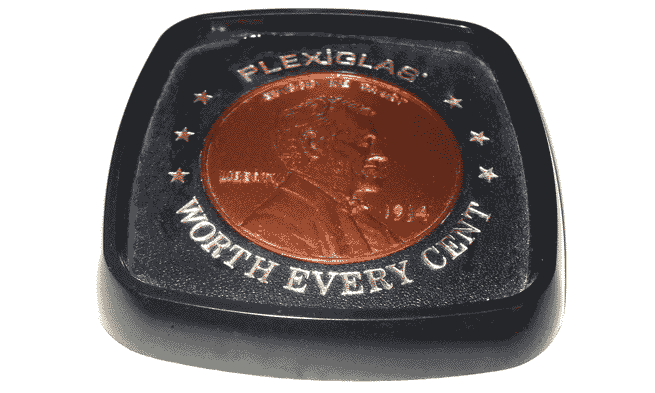
The company's purchasing department was told to order several thousand and did so .... but had them molded in polystyrene "because it was cheaper"!!
Anyone familiar with plastic could easily spot the substitution - for one thing, the materials sounded completely different when tapped with, say, a ring - a common do-it-yourself materials identifier test. There were differences in appearance, too. And eventually, performance as well as durability. (posted 4/9/08, permalink)
Update: The Rohm & Haas brand disappeared and its stock ceased trading on April Fool's Day 2009, as Dow Chemical Co. closed on its $16.5 billion buyout of Rohm & Haas Co. - a deal that Dow hopes will fuel growth in the high-margin specialty chemicals market. Some R&H business assets "will form the core of a new advanced materials unit."
To save cash and make the integration as seamless as possible, Dow cut its dividend, moved to lay off thousands of Rohm & Haas workers and plans to sell several R&H assets, including Morton Salt. Dow has already agreed to sell Morton Salt to K+S Aktienesellschaft, Europe's largest salt producer, for $1.675 billion in cash to help finance the R&H acquisition.
Dow confirmed that "the agricultural unit - which has performed well, despite the recession - will not be sold." (added 4/2/09)
Update II: Dow Chemical Co. is closing the former Rohm and Haas 68-acre chemical plant in Philadelphia's Bridesburg section. At its peak, the plant employed close to 1,000 workers and ran 'round the clock.
Rohm and Haas has operated on the site since 1920, after acquiring the facility from Charles Lennig and Company, one of the oldest chemical manufacturers in the U.S. Founded in 1819, Lennig opened its Bridesburg facility in 1847. (added 5/20/10)
Call Reports: We live in an era of tweets, e-mails, sales management software and cloud computing. The time of the old sales call report is dead. These paper sales documents were once dictated to secretaries - either in person, via Dictabelt or using a microcassette recorder - who later typed, duplicated and distributed them.
 Every person who ever worked at a large company has a collection of favorite call reports. Mine includes a couple of hilarious Rohm & Haas Plastics Department call reports on Naked City, an Indiana nudist camp that wanted to purchase a large quantity of clear Plexiglas sheet for various projects. Every person who ever worked at a large company has a collection of favorite call reports. Mine includes a couple of hilarious Rohm & Haas Plastics Department call reports on Naked City, an Indiana nudist camp that wanted to purchase a large quantity of clear Plexiglas sheet for various projects.
In his first report of November 1969, J. R. Reid, the reporting salesman out of the Chicago office, described the place as "located between a defunct VFW Post and Bargain City (used furniture) in pastoral Roselawn, Indiana."
The first report is chock full of humorous incidents and observations.
"There was no requirement to undress but neither was there an apparent effort on the part of our prospective customers to cover themselves before our arrival. Mrs. (name redacted, wife of the Plexiglas distributor who participated in this joint sales call) appeared somewhat discomfited but conducted herself with great dignity A small incident did mar the solemnity of the presentation - a naked man walked directly in front of Mrs. (redacted).
In a maidenly effort to avert direct perusal, she elected to relocate her purse from the chair beside her to what she took to be a coffee table. Alas, it was a topless Plexiglas hemisphere filled with water and lilies - the purse settled quietly to the bottom but was retrieved without too great an effort by the writer."
To the best of my knowledge, neither R&H nor any of its authorized distributors ever received a substantial order from Naked City, despite a technical service call made by Rohm & Haas' tech rep. In a subsequent report, Jack Reid lavished praise on his tech support guy, George Fisher, noting that "he conducted himself in an exemplary manner ... except for dilation of his pupils (his eyes looked like an owl's with a flashlight shined in its face) and a sharply higher respiratory rate."
The Saturday Evening Post published a very entertaining series of fictionalized call reports from the mythical Earthworm Tractor Co., serialized over two decades, starting in the late 1920s.
The author, William Hazlett Upson, turned his work experience with Caterpillar Company into a second career. His articles took the form of sales call reports, letters and internal memos involving Alexander Botts, self-described as a "natural-born salesman" whose ego knew no bounds.
Botts, despite little to no sales experience, had landed a job selling Earthworm tractors through sheer gumption. Each story related the mayhem caused as the tractor salesman extraordinaire extracted himself from some disastrous situation - in a creative, instructive and humorous way.
Excerpt from one report: "I got your letter yesterday, and it is a good thing you are putting onto this job a real high-powered salesman like me, rather than one of your ordinary men. When I explain the situation here, you will see that any ordinary man would have quit cold. But not Alexander Botts ..."
The series was later packaged as a book and, in 1936, was made into a movie, 'Earthworm Tractors', starring Joe E. Brown. I had a chance to watch the movie last month and, while it had its moments, the book - 'The Best Of Botts' - is much funnier. (posted 11/11/10, permalink)
RIP: John C. Haas, former chairman of Rohm & Haas has died at age 92. Son of co-founder Otto Haas, he was also active in philanthropic activities.
When Otto died in 1960, his other son, F. Otto Haas, took over the reigns of the Philadelphia-based company. F. Otto died in 1994 at age 78. (posted 4/4/11, permalink)
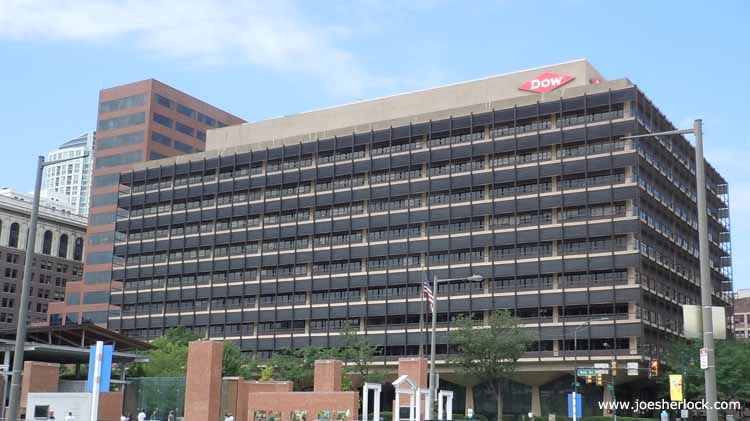
During a trip to Philadelphia in 2011, we observed that the former Rohm & Haas headquarters on Independence Mall West now sports a bright red diamond-shaped Dow logo on top and is referred to as the 'Dow Building'. No one has called it The Plexiglas Palace in many years.
Bring Back The Tom Thumb: If you worked for Rohm & Hass at their corporate headquarters in the 1960s and '70s, you'll surely remember the Tom Thumb Restaurant. James Lileks pointed out that, at the Tom Thumb Restaurant in Philadelphia, you could "enjoy delicious soup on the same spot where Thomas Jefferson penned" the Declaration of Independence.
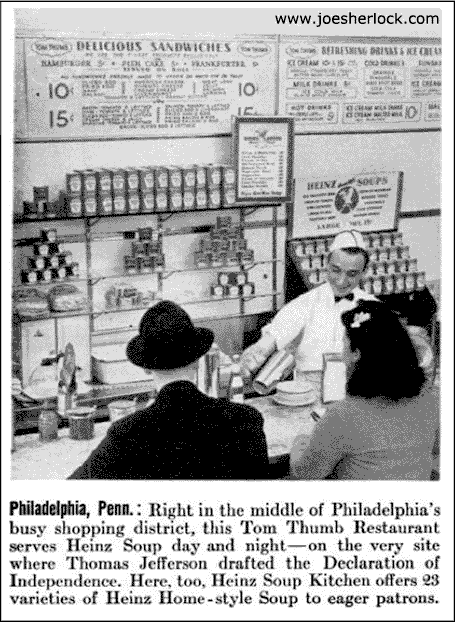
Now that's something I know about. The Tom Thumb Restaurant was located at 7th and Market Sts. - on the southwest corner - across from the Rohm & Haas' parking garage (next to Rohm & Haas' corporate headquarters). The Tom Thumb was very small - almost a lean-to but it was a good place to pick up coffee and a danish on the way to work, although it was usually quite busy at 8:00 am.
In 1975, as part of the Bicentennial Mania, they tore it down to make a Jefferson museum, now called the Declaration House. But the museum has closed. Maybe soon they'll tear that down and erect a 'historic' Tom Thumb restaurant replica. (posted 8/6/14, permalink)
In The Dark: I just remembered a humorous story from my days at the Plastics Engineering Laboratory in Bristol, PA. Expo 67 was Montreal's World's Fair which was held at Ile Ste-Hélène on the St. Lawrence River. The centerpiece of this 1967 fair was the U.S. Pavilion - covered by a gigantic, 20-story, see-through geodesic dome, designed by R. Buckminster Fuller. The segments of Bucky's dome were glazed with bronze-tinted Plexiglas acrylic sheet.
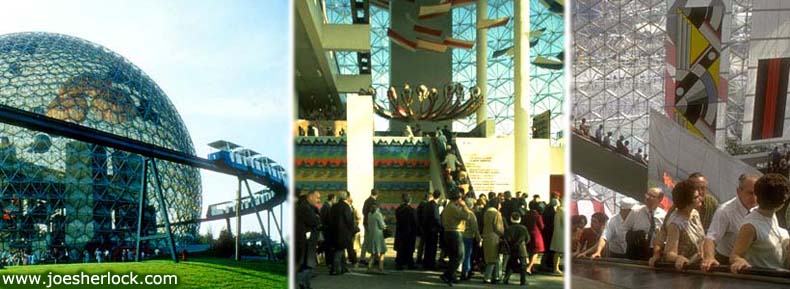
There were four or five different shades of transparent bronze used. The pieces near the top had the darkest shades; the ones near ground level were the lightest to create a gradient effect and reduce heat loads near the top. Hexagonal acrylic flat pieces were heated and free-blown (with air-pressure) to form low-rise bubble shapes. These were bolted to the welded steel skeletal structure. Because acrylic was flammable, the entire structure was sprinklered. As I recall, there was one sprinkler head for every Plexiglas panel.
The sprinkler system was plagued with leaks (low-bidder quality problems?), so the sprinkler system was turned off most of the time. In 1976, some welding repairs to the steel structure were being carried out. Despite the presence of an open flame neat the combustible acrylic, the sprinkler system was off and, when a fire started, no one present knew how to turn it back on. By the time it was turned on and the system repressurized, the dome was engulfed in flames. Poof!
Back in 1967, R&H decided to send one of their professional photographers (the PEL had a full-time one on staff) to get some documentary photos of the structure.
The photographer worked for a manager named Bob who was an arrogant, ex-military guy and professional know-it-all. (Think Dilbert's boss but with better posture and a brush cut.) Bob bumped the photographer from the trip and went himself. (I'm sure he thought, "Hey, Montreal - a chance to eat, drink and carouse on the company's money.") Even though he had no knowledge of photography, Bob declined any lessons.
He shot ten rolls of 35 mm film. When developed, all were blank. It was rumored that Bozo Bob never removed the lens cover. What an idiot! And what a pack of idiots were the R&H senior managers who never fired Bob.
Idiotic senior managers played a large part in my decision to leave Rohm & Haas in 1978. (posted 8/4/15, permalink)
My Life At The Plastics Engineering Lab: Recently, I came across some old photos and other materials which brought back fond memories from the early part of my post-collage career.
One was a publicity photo of a young me, working in front of the NATCO 400E injection molding machine at the Plastics Engineering Laboratory. I am pictured with technicians Johnnie Walker (center) and foreman Wayne Richmond (left):
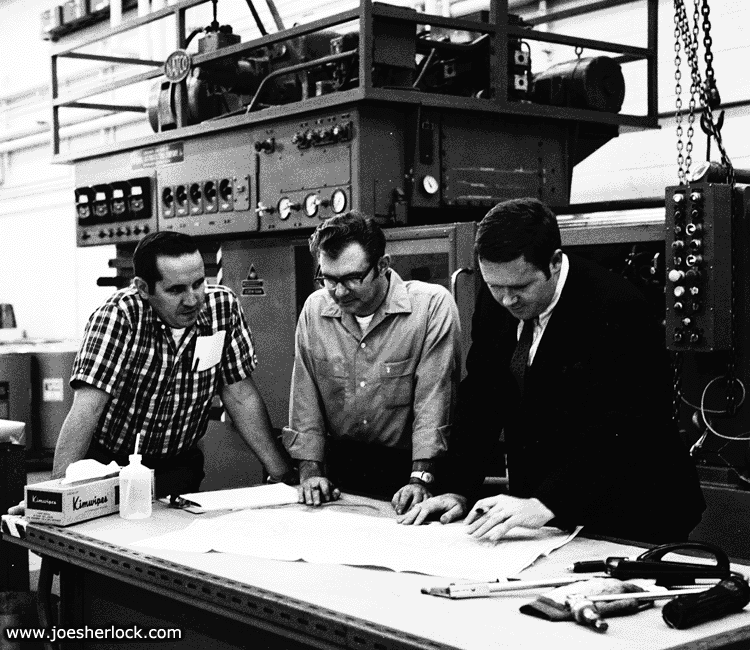
The photo was published in a Rohm & Haas Co. employee newsletter.
This was a good time in my career. I really enjoyed working at R&H - the pay was very good, the working conditions were many times better than my previous employer (I worked at the Uniroyal Timing and V-Belt Plant in Northeast Philadelphia for about a year after I graduated from college) and the fringe benefits were excellent.
Rohm and Haas always offered customer support for its plastics materials but ... (more >>>)
In Trust: John C. Haas was the last surviving child of F. Otto Haas, co-founder of Rohm & Haas Co. John C. died in 2011. John and his wife were big-time philanthropists.
Now there's this: "Adding a final jewel to the philanthropic legacy of John and Chara Cooper Haas, their children are donating the family's Stoneleigh Estate in Villanova to the conservation group Natural Lands Trust, which will manage it as a native-plants garden, open free to the public."
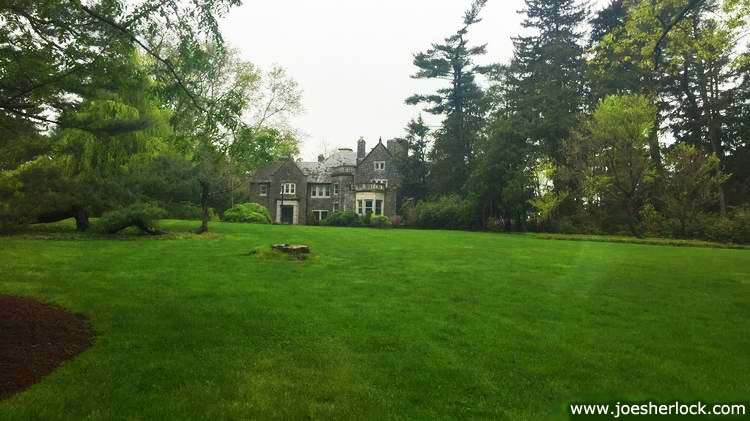
Stoneleigh's history dates to 1877, when Edmund Smith, a 19th Century Pennsylvania Railroad executive, bought 65 acres in Villanova and built a home. In 1932, after the land was subdivided, Otto Haas, John's father and cofounder of Rohm & Haas, purchased a portion. So began eight decades of Haas residency.
Current tax records put the estimated market value of the property at about $10 million.
The 42 acres and Tudor Revival mansion on North Spring Mill Road were transferred to the trust in a ceremony held on the Great Lawn behind the house.
Emotionally, "it is a passage, for sure," said David Haas, who was nine years-old when his parents acquired the estate from his grandparents in 1964. "But it is inspiring to think that this place" - where he, his four siblings, and cousins played and climbed trees - "will really be open, used, and appreciated by many different people." (posted 7/21/16, permalink)
Company Iron: The Old Motor published an article about salesmen's cars, including photos of a specially-outfitted 1950 Chevrolet station wagon with those simulated woodgrain panels on the exterior. Inside was a working lathe and milling machine from South Bend Lathe Co. The salesman could demonstrate the features of the machinery right at the prospective customer's doorstep.
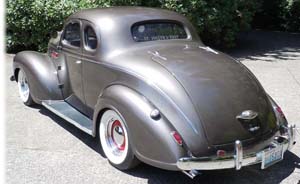 In the 1949 play, 'Death of a Salesman', Willy Loman carted his "two large sample cases" around in his car's trunk, probably that of a business coupe. Business coupes with their cavernous trunks - like my '39 Plymouth - were popular with traveling salesmen or field service people. In the 1949 play, 'Death of a Salesman', Willy Loman carted his "two large sample cases" around in his car's trunk, probably that of a business coupe. Business coupes with their cavernous trunks - like my '39 Plymouth - were popular with traveling salesmen or field service people.
After World War II, new three-box sedan designs provided everyday cars with larger trunks and caused the eventual demise of business coupes. Those who needed more carrying space bought new steel-bodied station wagons, such as South Bend Lathe's 1950 Chevy.
When I first began working at Rohm & Haas Co. in 1966, every salesperson in the Plastics Department had a large company-issued vehicle (full-size four-door sedan) with a big trunk to hold samples and information. Product literature, service bulletins, tech manuals and the like were carried by and given out by salesmen as needed - on the spot. None of this "I'll call the factory (or home office) and ask them to mail you something" nonsense. While waiting for the promised information to arrive, some other, better-prepared competitor's salesman might swoop in, literature in hand, and close the deal.
In the 1960s, the Plastics Department had 11 technical service people positioned throughout the U.S. to deal with customer problems. These men often carried sheets of acrylic plastic or sample drums of injection-molding compound for a specific job. Therefore, every tech service employee had a full-size company station wagon.
Bob Gardner, who was an early R&H Plastics Dept. employee, told me ... (more >>>)
Dennis J. Gartland: My very good friend Dennis Gartland passed away following a massive heart attack at age 70. He is survived by his loving wife, Sandy, as well as three wonderful sons - Michael, Brian and David - and a granddaughter, Casey, on whom he doted.
Dennis worked in the Plastics Department of Rohm and Haas Co. for many years. In addition to stints at the Bristol (PA) Plant and the home office in downtown Philadelphia, he was a plastics sales representative in New York, Connecticut, California and later served as district manager for the entire West Coast. When R&H sold off its plastics assets, Dennis continued to ... (more >>>)
Plastic Confusion: I am confounded by what companies now own brand names and who makes/sells what. General Electric no longer makes light bulbs or toasters. Buick seems to be more of a Chinese brand - it sells more vehicles there than in the U.S. Lexan, the tough, clear plastic once championed by General Electric is now owned by Saudi Basic Industries Corporation. Uniroyal tires - once the pride of Akron, Ohio - are now just a discount brand made by Michelin. The French tire company also makes BF Goodrich tires. Once a breakfast cereal company, Kellogg's now owns Pringles and Cheese-It snacks. Then there's the confusing story of the acrylic plastic industry.
Acrylic, also known as PMMA - Polymethyl Methacrylate, is a clear, rigid thermoplastic offering excellent see-through value (equivalent to optical-grade glass), hardness, breakage resistance (compared with glass), outstanding outdoor durability and light weight. It offers good chemical resistance and has desirable electrical properties - low conductivity, good arc resistance and dielectric strength. Acrylic is available in dimensional form (sheet, rod and tube) as well as a molding compound for producing manufactured shapes by injection-molding or extrusion. Initially employed for aircraft canopies during World-War II, acrylic is used extensively for architectural and safety glazing, architectural lighting, clear point-of-purchase and retail displays, aquariums, outdoor signs (in translucent colors) and red-tinted automotive tail lamps.
Acrylic plastic was developed ... (more >>>)
Concepts In Plexiglas: Mort Blumenfeld was manager of industrial design at Rohm and Haas' plastics marketing development group from 1952-69. Mort was a renowned industrial designer.
Mort was quite a raconteur with a large stable of jokes and funny stories. Whenever he visited the PEL, I enjoyed talking about car design with him because of his knowledge of Detroit design and Designers. He was later inducted into the Academy of Fellows of the Industrial Designers Society of America, joining such luminaries as Gene Bordinat (former Ford VP of Design), Henry Drefuss, Raymond Loewy, Brooks Stevens and Norman Bel Geddes.
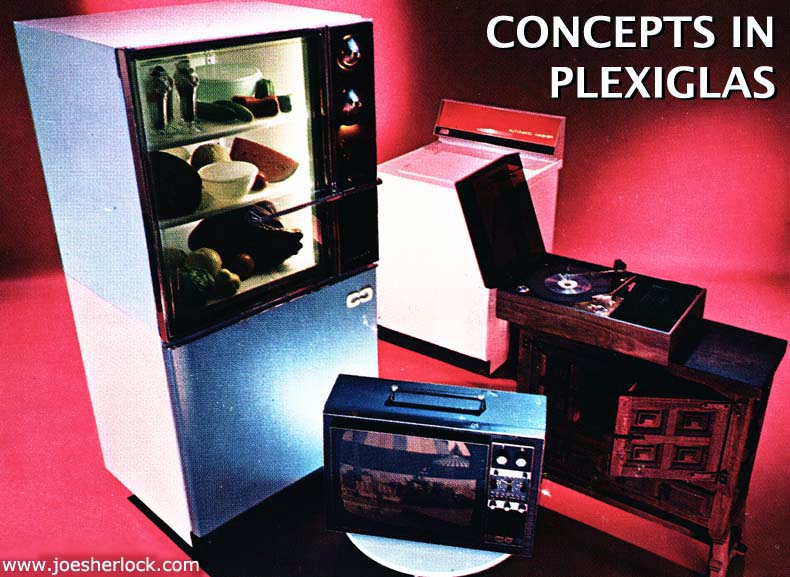
During his tenure at Rohm and Haas, Mr. Blumenfeld spearheaded Concepts In Plexiglas, a 1966 program and traveling exhibit, designed to promote wider use of acrylic plastic in the appliance market. Mort died in 2011 at age 92 in Sun City, CA. (posted 6/27/18, permalink)
Rohm and Haas Explorer Concept Cars: In the 1960s, Rohm and Haas Co., a Philadelphia-based chemical and plastics firm - best known for its acrylic thermoplastic, Plexiglas, developed a series of five 'Explorer' concept cars to showcase the use of Plexiglas as well as other Rohm and Haas products in automobiles.
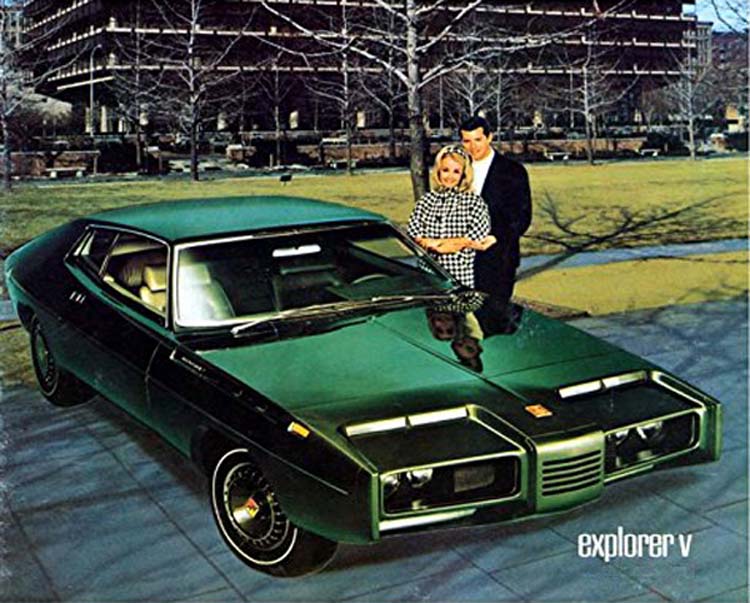
Most Explorer cars had four things in common ... (more >>>)
 I Met Him Once Or Twice: Vincent L. Gregory Jr., retired president and CEO of the former Rohm & Haas Co., has died of a chronic respiratory illness at his home in Hampshire, England. He was 95. I Met Him Once Or Twice: Vincent L. Gregory Jr., retired president and CEO of the former Rohm & Haas Co., has died of a chronic respiratory illness at his home in Hampshire, England. He was 95.
Vince Gregory was born into a poor family with 9 children in Oil City, PA. Because his father had trouble finding work during the Great Depression, young Vince chopped firewood to help support his family. Gregory was a fighter pilot in Europe during World War II and joined Rohm & Haas in 1949 as a junior accountant responsible for conducting internal audits at three of the chemical company's plants.
Mr. Gregory served as head of Rohm & Haas from 1970 until retiring in 1988. He bore a bit of a resemblance to actor Richard Conte, who played the dapper Don Emilio Barzini in 'The Godfather'. Much of Gregory's tenure occurred during a tumultuous time for the U.S. economy and Rohm & Haas, too: the 1973 oil crisis, 1974-75 recession, late 1970s stagflation - followed by runaway inflation (topping out at 13.3% annually under Jimmy Carter, mortgage rates on conventional 30-year loans hit 18.63%), a major double-whammy recession during the 1980-82 period and the commoditization of many of the company's aging plastic offerings (Plexiglas, Implex, Kydex) in the 1980s with no significant new products in the pipeline. Nevertheless, Vince Gregory steered the ship as best he could, making acquisitions outside of R&H's traditional areas of operation and shedding some of the company's bloated workforce.
After his retirement, Vince and his wife continued to live in center city Philadelphia. In 2017, he moved to the United Kingdom to be near his children, grandchildren and great-grandchildren. RIP. (posted 6/11/19, permalink)
Ave Atque Vale: It is with sadness that I announce the passing of Dr. Henry J. Gambino. He died in Doylestown, PA a few months ago after a long battle with Parkinson's and the effects of a stroke he suffered five year ago. His wife, Maureen, preceded him in death a couple of months earlier. She was 77.
Dr. Gambino was a good friend and a brilliant guy. Harry (as his friends called him) was ... (more >>>)
"You have To Stay In The Game." Rohm and Haas Company's Management Assessment Center was a program of tests which would reveal who was a candidate for top management and who wasn't. In 1977, I was selected to be assessed. I was 34 years-old at the time and had been rising through the company's ranks at a pretty good pace with commensurate salary increases.
Read about my experience with the Assessment Center here.
Riddle: What's the connection between Bad Managers and Pontiac Sunbirds? Find the answer here.
copyright 2008-21 - Joseph M. Sherlock - All applicable rights reserved
Disclaimer
The facts presented on this website are based on my best guesses and my substantially faulty geezer memory. The opinions expressed herein are strictly those of the author and are protected by the U.S. Constitution. Probably.
Spelling, punctuation and syntax errors are cheerfully repaired when I find them; grudgingly fixed when you do.
If I have slandered any brands of automobiles, either expressly or inadvertently, they're most likely crap cars and deserve it. Automobile manufacturers should be aware that they always have the option of trying to change my mind by providing me with vehicles to test drive.
If I have slandered any people or corporations, either expressly or inadvertently, they should buy me strong drinks (and an expensive meal) and try to prove to me that they're not the jerks I've portrayed them to be. If you're buying, I'm willing to listen.
Don't be shy - try a bribe. It might help.
|
|

